lock NISSAN QUEST 2002 V41 / 2.G Owners Manual
[x] Cancel search | Manufacturer: NISSAN, Model Year: 2002, Model line: QUEST, Model: NISSAN QUEST 2002 V41 / 2.GPages: 294, PDF Size: 2.49 MB
Page 10 of 294
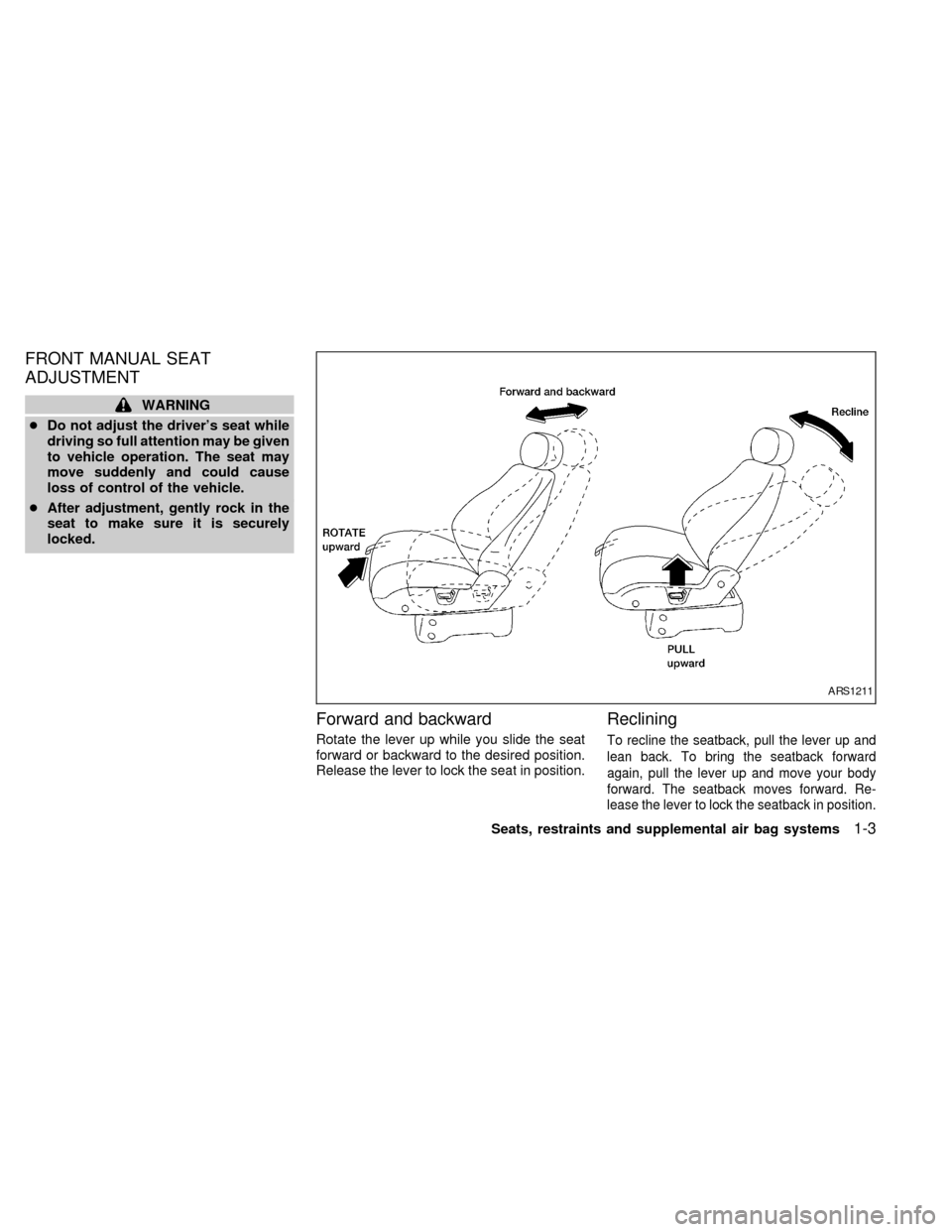
FRONT MANUAL SEAT
ADJUSTMENT
WARNING
cDo not adjust the driver's seat while
driving so full attention may be given
to vehicle operation. The seat may
move suddenly and could cause
loss of control of the vehicle.
cAfter adjustment, gently rock in the
seat to make sure it is securely
locked.
Forward and backward
Rotate the lever up while you slide the seat
forward or backward to the desired position.
Release the lever to lock the seat in position.
Reclining
To recline the seatback, pull the lever up and
lean back. To bring the seatback forward
again, pull the lever up and move your body
forward. The seatback moves forward. Re-
lease the lever to lock the seatback in position.
ARS1211
Seats, restraints and supplemental air bag systems1-3
ZX
Page 14 of 294
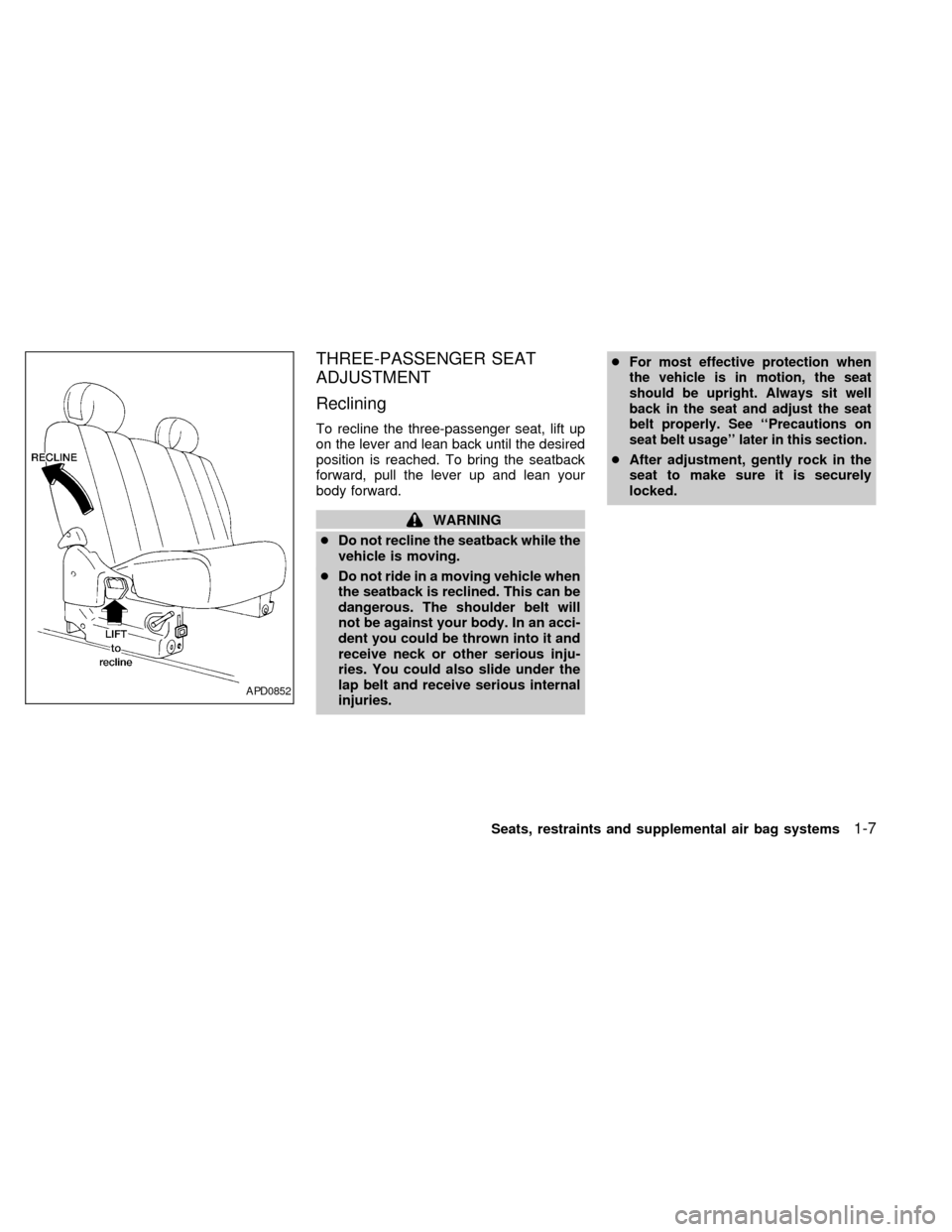
THREE-PASSENGER SEAT
ADJUSTMENT
Reclining
To recline the three-passenger seat, lift up
on the lever and lean back until the desired
position is reached. To bring the seatback
forward, pull the lever up and lean your
body forward.
WARNING
cDo not recline the seatback while the
vehicle is moving.
cDo not ride in a moving vehicle when
the seatback is reclined. This can be
dangerous. The shoulder belt will
not be against your body. In an acci-
dent you could be thrown into it and
receive neck or other serious inju-
ries. You could also slide under the
lap belt and receive serious internal
injuries.c
For most effective protection when
the vehicle is in motion, the seat
should be upright. Always sit well
back in the seat and adjust the seat
belt properly. See ``Precautions on
seat belt usage'' later in this section.
cAfter adjustment, gently rock in the
seat to make sure it is securely
locked.
APD0852
Seats, restraints and supplemental air bag systems1-7
ZX
Page 15 of 294

Sliding
Before sliding the seat, fasten the center
belt tongue to the center buckle and remove
the appropriate floor mats.1. Lift the seat cushion release lever.
2. Lift the seat cushion up into the locked
position.
3. Lift the slide release lever and grasp the
bar under the seat in the center.
4. Slide the seat until locked at a passenger
seating position or a storage position.
After the seat starts moving, release the
slide lever. The seat latches at the next
latching position. Continue to lift and
release the slide lever until the desired
position is obtained.
To lower the cushion, the seat must be
locked at a passenger seating position. Lift
the seat cushion release lever and lower the
cushion until locked.
The seat cushion cannot be lowered in a
storage position. This prevents a pas-
senger from using a seat or seat belt that
is out of a seating position.
APD0853
1-8Seats, restraints and supplemental air bag systems
ZX
Page 16 of 294
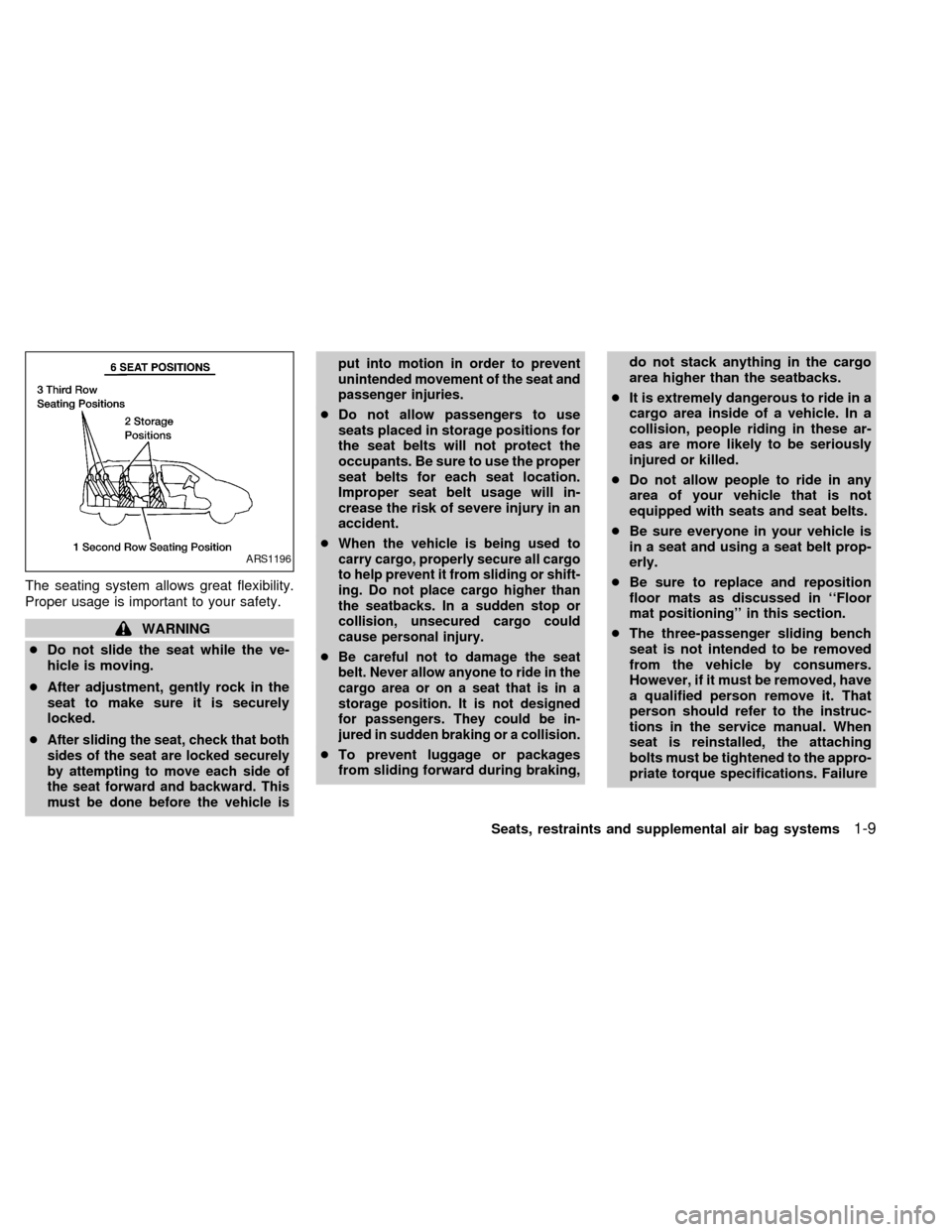
The seating system allows great flexibility.
Proper usage is important to your safety.
WARNING
cDo not slide the seat while the ve-
hicle is moving.
cAfter adjustment, gently rock in the
seat to make sure it is securely
locked.
c
After sliding the seat, check that both
sides of the seat are locked securely
by attempting to move each side of
the seat forward and backward. This
must be done before the vehicle isput into motion in order to prevent
unintended movement of the seat and
passenger injuries.
cDo not allow passengers to use
seats placed in storage positions for
the seat belts will not protect the
occupants. Be sure to use the proper
seat belts for each seat location.
Improper seat belt usage will in-
crease the risk of severe injury in an
accident.
c
When the vehicle is being used to
carry cargo, properly secure all cargo
to help prevent it from sliding or shift-
ing. Do not place cargo higher than
the seatbacks. In a sudden stop or
collision, unsecured cargo could
cause personal injury.
cBe careful not to damage the seat
belt. Never allow anyone to ride in the
cargo area or on a seat that is in a
storage position. It is not designed
for passengers. They could be in-
jured in sudden braking or a collision.
cTo prevent luggage or packages
from sliding forward during braking,do not stack anything in the cargo
area higher than the seatbacks.
cIt is extremely dangerous to ride in a
cargo area inside of a vehicle. In a
collision, people riding in these ar-
eas are more likely to be seriously
injured or killed.
cDo not allow people to ride in any
area of your vehicle that is not
equipped with seats and seat belts.
cBe sure everyone in your vehicle is
in a seat and using a seat belt prop-
erly.
cBe sure to replace and reposition
floor mats as discussed in ``Floor
mat positioning'' in this section.
cThe three-passenger sliding bench
seat is not intended to be removed
from the vehicle by consumers.
However, if it must be removed, have
a qualified person remove it. That
person should refer to the instruc-
tions in the service manual. When
seat is reinstalled, the attaching
bolts must be tightened to the appro-
priate torque specifications. Failure
ARS1196
Seats, restraints and supplemental air bag systems1-9
ZX
Page 19 of 294
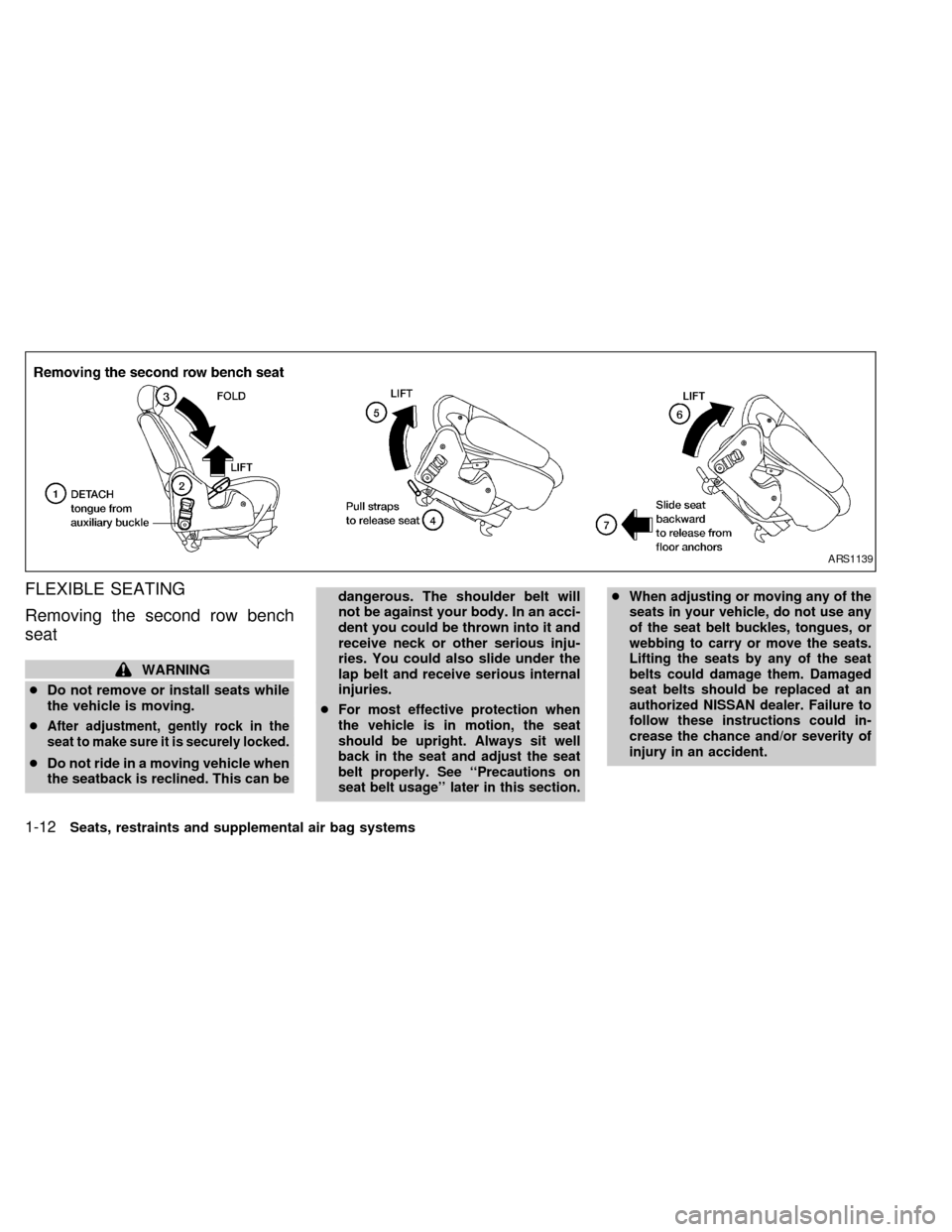
FLEXIBLE SEATING
Removing the second row bench
seat
WARNING
cDo not remove or install seats while
the vehicle is moving.
c
After adjustment, gently rock in the
seat to make sure it is securely locked.
cDo not ride in a moving vehicle when
the seatback is reclined. This can bedangerous. The shoulder belt will
not be against your body. In an acci-
dent you could be thrown into it and
receive neck or other serious inju-
ries. You could also slide under the
lap belt and receive serious internal
injuries.
c
For most effective protection when
the vehicle is in motion, the seat
should be upright. Always sit well
back in the seat and adjust the seat
belt properly. See ``Precautions on
seat belt usage'' later in this section.cWhen adjusting or moving any of the
seats in your vehicle, do not use any
of the seat belt buckles, tongues, or
webbing to carry or move the seats.
Lifting the seats by any of the seat
belts could damage them. Damaged
seat belts should be replaced at an
authorized NISSAN dealer. Failure to
follow these instructions could in-
crease the chance and/or severity of
injury in an accident.
ARS1139
1-12Seats, restraints and supplemental air bag systems
ZX
Page 20 of 294
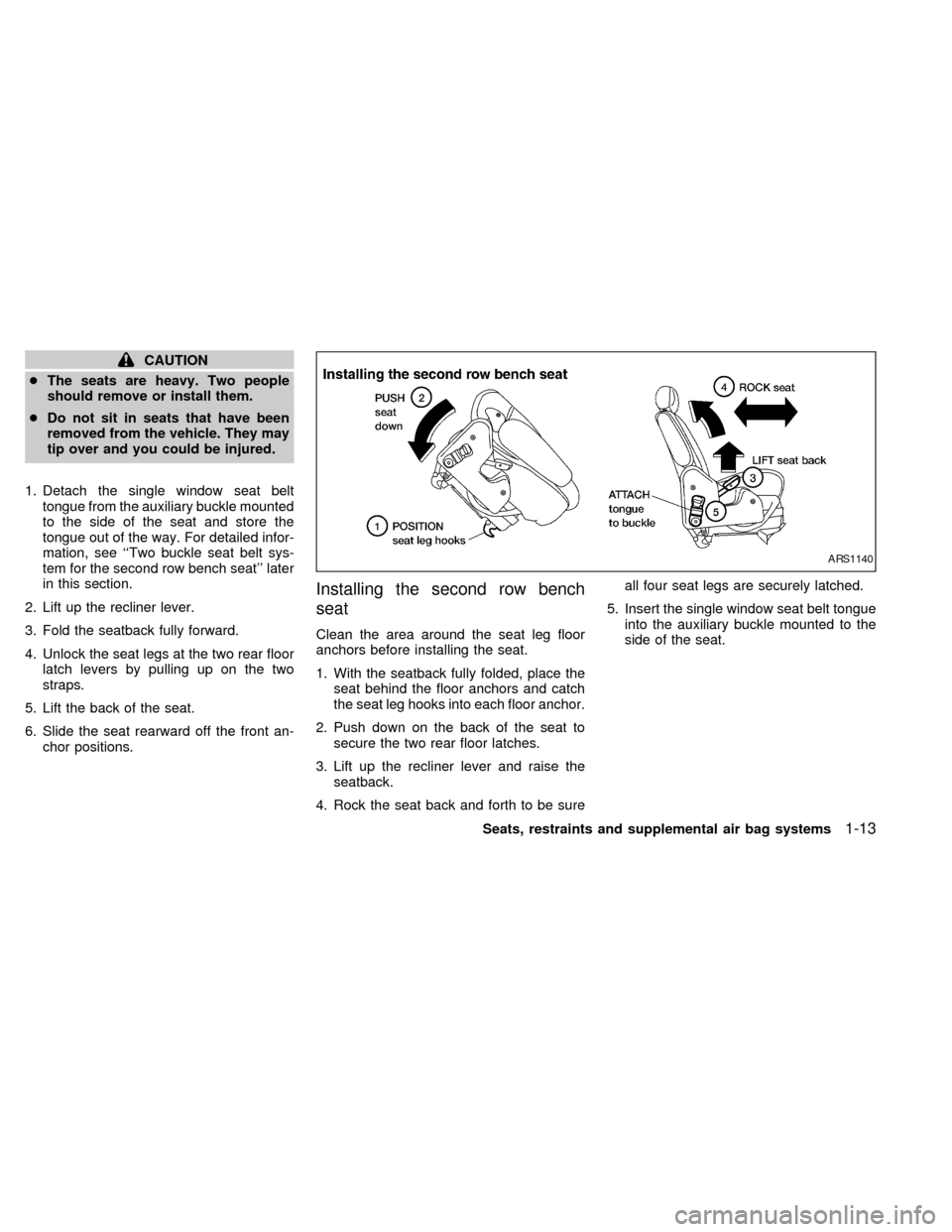
CAUTION
cThe seats are heavy. Two people
should remove or install them.
cDo not sit in seats that have been
removed from the vehicle. They may
tip over and you could be injured.
1. Detach the single window seat belt
tongue from the auxiliary buckle mounted
to the side of the seat and store the
tongue out of the way. For detailed infor-
mation, see ``Two buckle seat belt sys-
tem for the second row bench seat'' later
in this section.
2. Lift up the recliner lever.
3. Fold the seatback fully forward.
4. Unlock the seat legs at the two rear floor
latch levers by pulling up on the two
straps.
5. Lift the back of the seat.
6. Slide the seat rearward off the front an-
chor positions.
Installing the second row bench
seat
Clean the area around the seat leg floor
anchors before installing the seat.
1. With the seatback fully folded, place the
seat behind the floor anchors and catch
the seat leg hooks into each floor anchor.
2. Push down on the back of the seat to
secure the two rear floor latches.
3. Lift up the recliner lever and raise the
seatback.
4. Rock the seat back and forth to be sureall four seat legs are securely latched.
5. Insert the single window seat belt tongue
into the auxiliary buckle mounted to the
side of the seat.
ARS1140
Seats, restraints and supplemental air bag systems1-13
ZX
Page 21 of 294
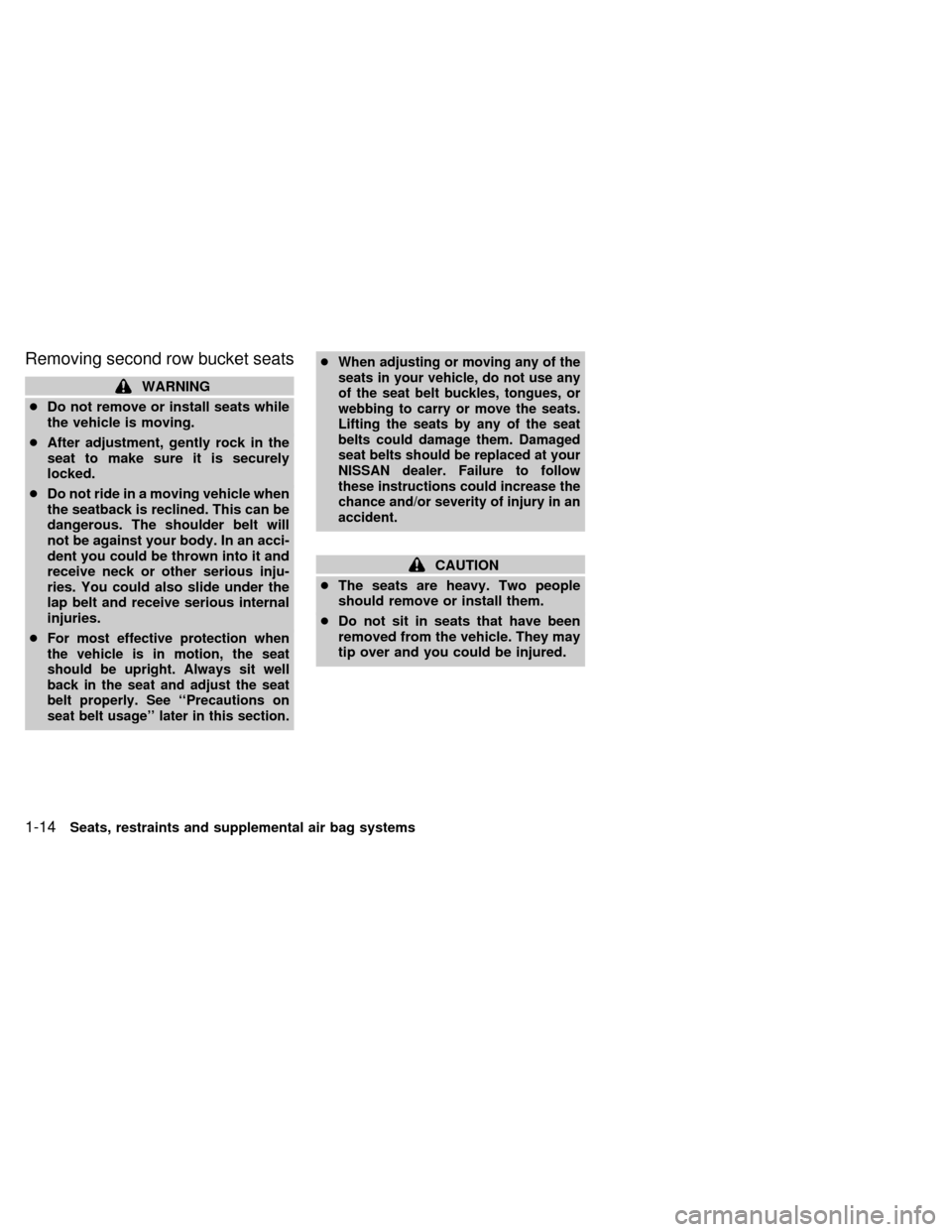
Removing second row bucket seats
WARNING
cDo not remove or install seats while
the vehicle is moving.
cAfter adjustment, gently rock in the
seat to make sure it is securely
locked.
cDo not ride in a moving vehicle when
the seatback is reclined. This can be
dangerous. The shoulder belt will
not be against your body. In an acci-
dent you could be thrown into it and
receive neck or other serious inju-
ries. You could also slide under the
lap belt and receive serious internal
injuries.
c
For most effective protection when
the vehicle is in motion, the seat
should be upright. Always sit well
back in the seat and adjust the seat
belt properly. See ``Precautions on
seat belt usage'' later in this section.cWhen adjusting or moving any of the
seats in your vehicle, do not use any
of the seat belt buckles, tongues, or
webbing to carry or move the seats.
Lifting the seats by any of the seat
belts could damage them. Damaged
seat belts should be replaced at your
NISSAN dealer. Failure to follow
these instructions could increase the
chance and/or severity of injury in an
accident.
CAUTION
cThe seats are heavy. Two people
should remove or install them.
cDo not sit in seats that have been
removed from the vehicle. They may
tip over and you could be injured.
1-14Seats, restraints and supplemental air bag systems
ZX
Page 23 of 294

3. Unlock the seat legs at the two rear floor
latch levers by pulling up on the two
straps.
4. Lift the back of the seat and slide it
rearward off the front anchor positions.
ARS1143
1-16Seats, restraints and supplemental air bag systems
ZX
Page 45 of 294
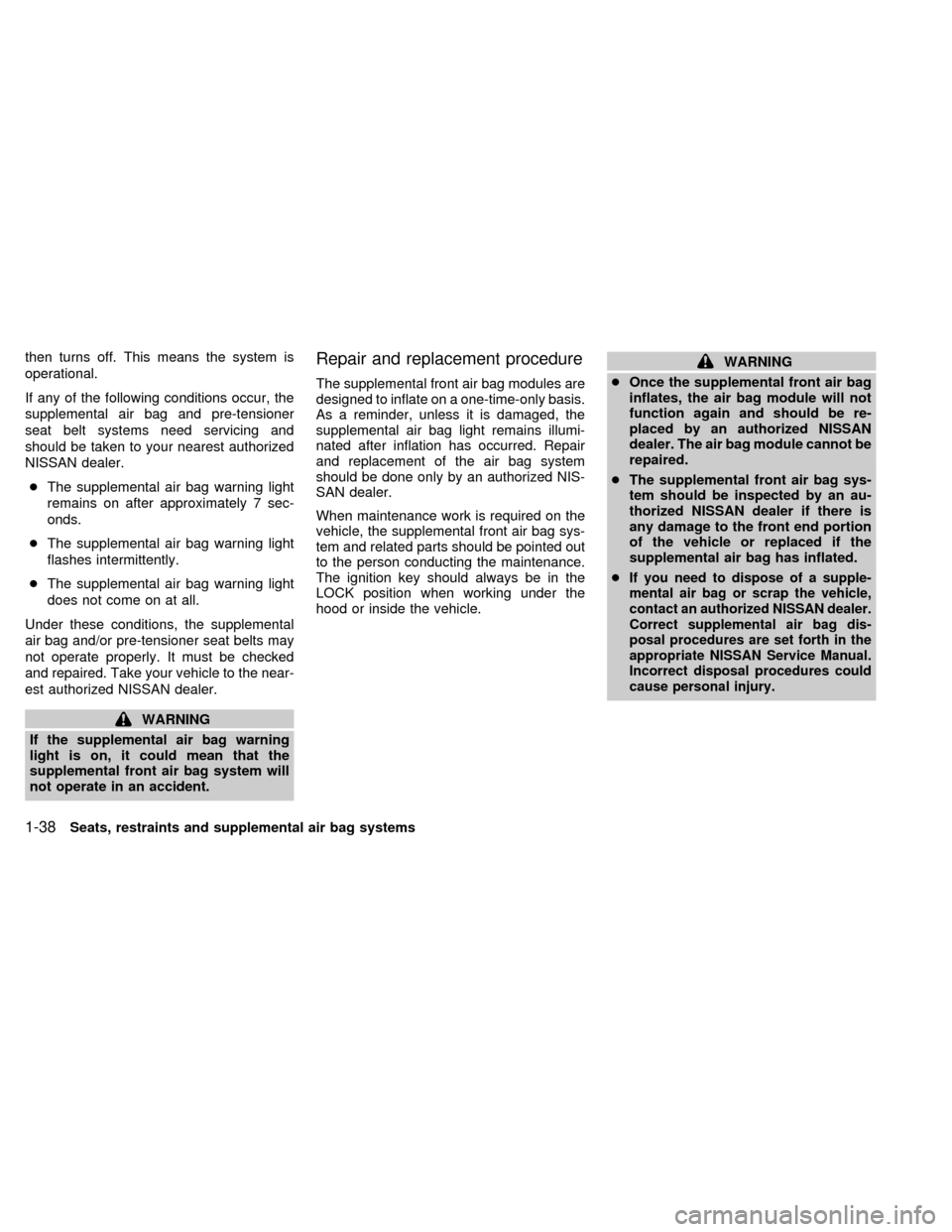
then turns off. This means the system is
operational.
If any of the following conditions occur, the
supplemental air bag and pre-tensioner
seat belt systems need servicing and
should be taken to your nearest authorized
NISSAN dealer.
cThe supplemental air bag warning light
remains on after approximately 7 sec-
onds.
cThe supplemental air bag warning light
flashes intermittently.
cThe supplemental air bag warning light
does not come on at all.
Under these conditions, the supplemental
air bag and/or pre-tensioner seat belts may
not operate properly. It must be checked
and repaired. Take your vehicle to the near-
est authorized NISSAN dealer.
WARNING
If the supplemental air bag warning
light is on, it could mean that the
supplemental front air bag system will
not operate in an accident.
Repair and replacement procedure
The supplemental front air bag modules are
designed to inflate on a one-time-only basis.
As a reminder, unless it is damaged, the
supplemental air bag light remains illumi-
nated after inflation has occurred. Repair
and replacement of the air bag system
should be done only by an authorized NIS-
SAN dealer.
When maintenance work is required on the
vehicle, the supplemental front air bag sys-
tem and related parts should be pointed out
to the person conducting the maintenance.
The ignition key should always be in the
LOCK position when working under the
hood or inside the vehicle.
WARNING
cOnce the supplemental front air bag
inflates, the air bag module will not
function again and should be re-
placed by an authorized NISSAN
dealer. The air bag module cannot be
repaired.
cThe supplemental front air bag sys-
tem should be inspected by an au-
thorized NISSAN dealer if there is
any damage to the front end portion
of the vehicle or replaced if the
supplemental air bag has inflated.
c
If you need to dispose of a supple-
mental air bag or scrap the vehicle,
contact an authorized NISSAN dealer.
Correct supplemental air bag dis-
posal procedures are set forth in the
appropriate NISSAN Service Manual.
Incorrect disposal procedures could
cause personal injury.
1-38Seats, restraints and supplemental air bag systems
ZX
Page 50 of 294

Fastening the seat belts
1. Adjust the seat.
2. Slowly pull the seat belt out of the retrac-
tor and insert the tongue into the buckle
until you hear and feel the latch engage.
The retractor is designed to lock during
a sudden stop or on impact. A slow
pulling motion permits the seat belt to
move, and allows you some freedom of
movement in the seat.3. Position the lap belt portionlow and
snug on the hipsas shown.
4. Pull the shoulder belt portion toward the
retractor to take up extra slack.
The front seat passenger seat belt and rear
three-point seat belts have a cinching
mechanism for child restraint installation. It is
referred to as the automatic locking mode.
When the automatic locking mode is acti-
vated, the seat belt cannot be withdrawn
again until the seat belt tongue is detached
from the buckle and fully retracted. Refer to``Child restraints'' later in this section for
more information.
The automatic locking mode should be
used only for child restraint installation.
During normal seat belt use by a passen-
ger, the locking mode should not be
activated. If it is activated, it may cause
uncomfortable seat belt tension.
ARS1161ARS1162
Seats, restraints and supplemental air bag systems1-43
ZX